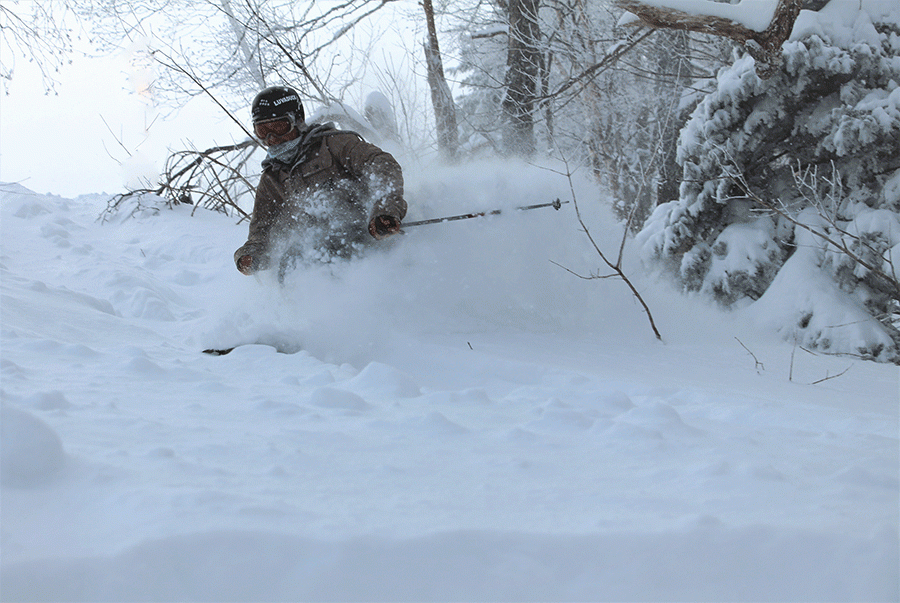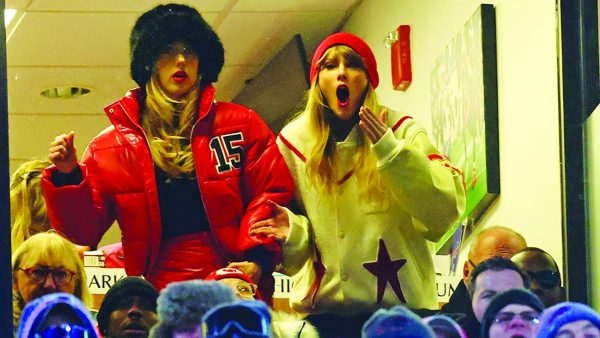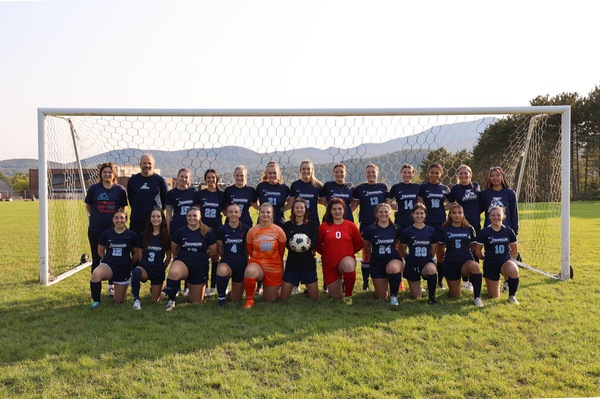For mountain resorts, coping with climate change is key
Jon Trembley at Jay Peak
As the effects of climate change seem to become more and more of a reality, Vermont resorts like Jay Peak, Okemo and Smugglers Notch are taking advantage of all the new technologies that they can.
Jay Peak Resort General Manager Steve Wright says that looking at climate change varies by resort, but that the industry as a whole is paying a lot of attention to it. “Overall, climate change is still looked at as being a down-the-road issue when it comes to most resorts for the time being,” said Wright.
That said, Wright notes that most resorts have been developing or are looking into developing as many “climate-independent” forms of recreation as they can. “We’ve done it here at Jay,” says Wright. “Skating and waterpark venues are not weather-critical assets. To an extent, these assets are summer based and don’t require ‘snow’ to be successful.”
Chloe Elliott, communications manager for ski Vermont, says that while it is no question that climate change and global warming are occurring, the average snowfalls over the past ten years in Vermont don’t quite reflect all of this.
With an average snowfall of 227 inches during the 2006-2007 season, stats have recently echoed these numbers during the 2013-2014 season with an average snowfall of 220 inches.
The 2015-2016 ski and ride season was the lowest average snowfall year for resorts in Vermont in the past 10 years with an almost unbelievable 107 inches. The second lowest snowfall in recent years was during the 2009-2010 season with 173 inches.
With the seemingly unpredictable numbers regarding natural snow, Director of Public Relations at Okemo Bonnie MacPherson says that at this point many resorts don’t rely much on natural snowfall for business. “People may see that we have snow here, but until they really see it in their own backyards they don’t necessarily act on it,” she said. “It’s great when Connecticut gets a snow storm even if we don’t get it, because it’s the best marketing tool we can have. I don’t know how we could possibly counter act that in the future.”
MacPherson notes that for the most part they haven’t done too much at Okemo in terms of projecting long term weather patterns or climate change. “We are trying to be proactive in being ahead of things with the technology that is available; climate change hasn’t been playing a huge role in our day to day operations quite yet. We are looking at things in terms of weather opposed to the overall climate for the time being,” said MacPherson.
According to vtclimate.org, the average annual state temperature has increased by 1.3 degrees Fahrenheit since 1960, and 45 percent of this has occurred since 1990. They note that warmer temperatures have caused later “first-fall freezes” and earlier “last-spring freezes,” and that over the past 40 years, the freezing period has shortened by 4 days each 10 years and the growing season has lengthened by 3.7 days every 10 years.
With this, they say that precipitation will continue to increase during the winter months, and that since 1960, average annual precipitation has increased 5.9 inches. They note that nearly half of this change in rainfall has occurred since 1990, with the greatest increases are in the mountainous regions.
Mike Chait, public relations director at Smugglers Notch, says that they began working with new technologies when beginning new developments roughly five years ago. “We are basically doing everything we can to keep our carbon footprint as small as we can with new technology on and off the mountain,” said Chait. “Since we started investing millions and millions of dollars into our snowmaking system, we have divided the amount of power and energy that is used to produce that snow in half.”
From a snowmaker’s standpoint, Jay Peak Mountain Operations worker Corey Guillette says that their general goal for the season is to push and make enough snow so that they can hopefully drag the season out to May. “In the future the main effect that climate shifts will have will be on the non-snowmaking terrain,” says Guillette.
That said, Guillette notes that future expansions of their snowmaking operations may need to occur. “We have talked about the numbers that would come with developing a way to run water from a large nearby river up to the mountain for snowmaking,” he said. “This would be roughly a 7 million dollar project.”
Both Smuggs and Okemo have already developed ways to draw water from large rivers near their resorts resulting in less stress when it comes to having enough water for snowmaking each season. Currently Jay is more limited when it comes to water usage. They draw from streams that run off of the mountain, making a wet fall season a necessity.
To develop a similar water pumping system like Smuggs and Okemo, Guillette says that they would have to put a pump house in at the river, run seven miles of pipeline to one of Jays snowmaking buildings and pump 2,000 gallons per minute out of the snowmaking building.
“Looking towards the future with this idea, we could increase our GPM usage to something ranging from four to six thousand,” he said. “This way we can make the proper amount of snow given narrow windows of cold nights. We will usually get two days of cold weather, then a few days of warm weather in the fall.”
Additionally, Guillette said that if this happens in the future they would be able to send a bunch of water up the mountain at the predicted 6,000 GPM and be able to cover three times the acreage with a narrow window.
With snowmaking, MacPherson says that they don’t solely rely on it, but that Okemo is in a good position as long as temperatures allow them to make snow. “Twenty-seven degrees Fahrenheit is our magic number, where we can use our newer guns,” said MacPherson. “We could push snowmaking closer to the freezing mark, but it might cost a little more. This might be something in the near future where newer technology might help us adapt to everything.”
As winter weather seems to become more and more unpredictable, Chait pointed out that industry wide they have been seeing a trend in the behavior of typical vacation guests doing a lot of last-minute booking. “We don’t see people booking their winter vacations in the summer as much; people are waiting to see what the weather will be like before booking,” he said. “This makes it a little harder to predict where the numbers will be, but we still do all right when aiming for our targets.”
With last minute vacation planning become normality’s, families may end up choosing to stay at the resorts that offer a number of “climate-independent” forms of recreations as Wright noted.
At Okemo, MacPherson says that they have been working on long-term investments to weather proofing the resort. “If people have kids and go on a ski vacation and the weather is bad, they are going to plan on going somewhere with weatherproof activities,” said MacPherson. “Last winter was brutal and we weren’t able to open our outdoor ice arena very much, so we installed a new glycol ice mat for outdoor skating that we can have open at up to roughly sixty degrees now. It really comes down to utilizing technology in a way to help increase revenue.”
For a resort to be environmentally conscious when it comes to climate change, Chait says that it all starts high up with management. “Everybody here at Smuggs understands that they have a role to protect the environment in which we live and to continue to progress our business in a way that is the least impacting on the environment around us,” said Chait.
On a larger state level of environment consciousness, Elliott noted the carbon tax proposal that has been on the table in Vermont for some time now, which, if passed, could raise gas prices by as much as 88 cents per gallon. “Luckily for now given the state’s current economics, this tax has not been passed, and it is likely that it won’t until a national or regional model is put in place,” said Elliott.
At our current climate standpoint, Elliott says that there is no telling what will happen with powder days here in Vermont. “As of right now we classify powders days as six inches or more in a twenty-four hour period, and we hope to enjoy many more to come,” said Elliott.
As for this season, Mother Nature has been sharing the wealth of snow that the west coast had received in January while the east coast experienced an unwelcomed January thaw. Following old Punxsutawney Phil seeing his shadow on Feb. 2, the east coast had been getting hammered with consistent snowfall week after week.
There have recently been a few warm ups throughout the state that pushed temperatures well into the 50s on Feb. 23 and March. 1. These events brought a couple of premature snow incidents. The overall snowpack is beginning to see an impact on the majority of natural snow based trails, as rock and grass patches have been peeping through the snow across the state.
Vtclimate.org predicts that Vermont’s temperatures are projected to rise by another 2-3.6 degrees Fahrenheit by 2050, and within 30-40 years, most winter precipitation will fall as rain and result in shorter-lasting snowpack and overall snowfall.
Given these predictions and potential soon-to-be realities, only time will tell when seeing what will happen to Vermont’s beloved and cherished niche in the ski and ride industry.
(Basement Medicine reached out to Stowe Mountain Resort, Sugarbush Mountain Resort and Killington Mountain Resort for comments on this topic; due to press deadlines and the high business levels at resorts across the state during the presidents’ week holiday time period, we have not received feedback at this time.)









